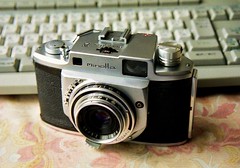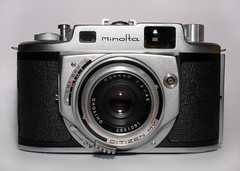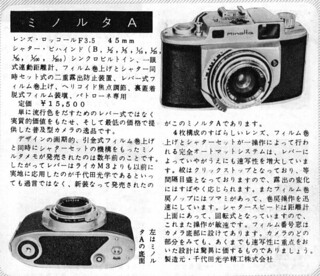Difference between revisions of "Minolta A"
Hanskerensky (talk | contribs) (Added link to user manual page) |
Nparsons13 (talk | contribs) m |
||
| Line 10: | Line 10: | ||
</div> | </div> | ||
| − | The '''Minolta A''' was launched by [[Chiyoda Kōgaku Seikō]] in April 1955<ref>JCII/Lewis, ed. "The History of Japanese Cameras" p194.</ref> as the first of their new series of rangefinder cameras. It has an optical viewfinder with superimposed coupled rangefinder, a shutter speed thumb wheel on top of the camera and a rapid wind advance lever. The first version has a two-blade [[Konan]] Flicker shutter with speeds B and 1/2 to 1/200 second. The second version has an [[Optiper]] MX shutter with B and 1 | + | The '''Minolta A''' was launched by [[Chiyoda Kōgaku Seikō]] in April 1955<ref>JCII/Lewis, ed. "The History of Japanese Cameras" p194.</ref> as the first of their new series of rangefinder cameras. It has an optical viewfinder with superimposed coupled rangefinder, a shutter speed thumb wheel on top of the camera, and a rapid wind advance lever. The first version has a two-blade [[Konan]] Flicker shutter with speeds B and 1/2 to 1/200 second. The second version has an [[Optiper]] MX shutter with B and 1 to 1/300 second, and the third version, released in 1956, has a [[Citizen]] MX shutter with B and 1 to 1/300 second.<ref>Sugiyama/Naoi "The Collectors Guide to Japanese Cameras", code numbers 3431, 3432, 3433.</ref> All were M and X flash-synchronized. The camera's coupled 45mm f/3.5-22 'Chiyoko [[Rokkor]]' lens, with 4 elements in 3 groups, was the first in a Japanese camera to use an equally spaced linear aperture scale<ref>JCII/Lewis, ed. "The History of Japanese Cameras" p91.</ref>. |
| − | It was an entry level camera for advanced 35mm photography that was ahead of more expensive popular American rangefinder camera models. The Minolta 'A' series was developed through the [[Minolta A-2|model A-2]], A-3, A-5, and then into the AL series that were marketed alongside the Hi-Matics. | + | It was an entry-level camera for advanced 35mm photography that was ahead of more expensive popular American rangefinder camera models. The Minolta 'A' series was developed through the [[Minolta A-2|model A-2]], A-3, A-5, and then into the AL series that were marketed alongside the Hi-Matics. |
<br style="clear:both;"/> | <br style="clear:both;"/> | ||
Latest revision as of 13:09, 21 January 2023

|
| image by Voxphoto (Image rights) |
The Minolta A was launched by Chiyoda Kōgaku Seikō in April 1955[1] as the first of their new series of rangefinder cameras. It has an optical viewfinder with superimposed coupled rangefinder, a shutter speed thumb wheel on top of the camera, and a rapid wind advance lever. The first version has a two-blade Konan Flicker shutter with speeds B and 1/2 to 1/200 second. The second version has an Optiper MX shutter with B and 1 to 1/300 second, and the third version, released in 1956, has a Citizen MX shutter with B and 1 to 1/300 second.[2] All were M and X flash-synchronized. The camera's coupled 45mm f/3.5-22 'Chiyoko Rokkor' lens, with 4 elements in 3 groups, was the first in a Japanese camera to use an equally spaced linear aperture scale[3].
It was an entry-level camera for advanced 35mm photography that was ahead of more expensive popular American rangefinder camera models. The Minolta 'A' series was developed through the model A-2, A-3, A-5, and then into the AL series that were marketed alongside the Hi-Matics.

|
| Plump body shape image by Voxphoto (Image rights) |

|
| First Minolta 'A' version has horizontal grooves on rewind knob image by zuikou (Image rights) |

|
| image by wolf4max (Image rights) |
Notes

|
| Column in the October 1955 special issue of Photo Art. Scan by rebollo_fr (Image rights) |
Links
In English:
- Minolta A user manual at Butkus.org
- Minolta A at Silverbased (archived)
- Minolta A repair notes at Dan Mitchell's camera site
In French:
- Minolta A on www.collection-appareils.fr by Sylvain Halgand